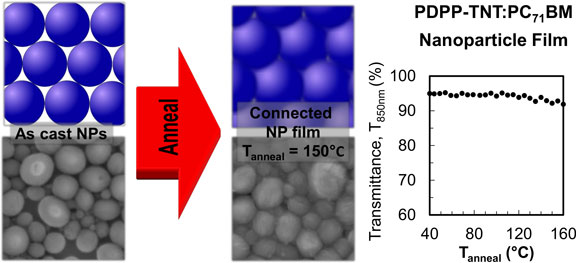Crossref Citations
This article has been cited by the following publications. This list is generated based on data provided by
Crossref.
Holmes, Natalie P.
Vaughan, Ben
Williams, Evan L.
Kroon, Renee
Andersson, MatsR.
Kilcoyne, A. L. David
Sonar, Prashant
Zhou, Xiaojing
Dastoor, Paul C.
and
Belcher, Warwick J.
2017.
Erratum: Diketopyrrolopyrrole-based polymer:fullerene nanoparticle films with thermally stable morphology for organic photovoltaic applications—CORRIGENDUM.
MRS Communications,
Vol. 7,
Issue. 2,
p.
286.
Holmes, Natalie P.
Marks, Melissa
Cave, James M.
Feron, Krishna
Barr, Matthew G.
Fahy, Adam
Sharma, Anirudh
Pan, Xun
Kilcoyne, David A. L.
Zhou, Xiaojing
Lewis, David A.
Andersson, Mats R.
van Stam, Jan
Walker, Alison B.
Moons, Ellen
Belcher, Warwick J.
and
Dastoor, Paul C.
2018.
Engineering Two-Phase and Three-Phase Microstructures from Water-Based Dispersions of Nanoparticles for Eco-Friendly Polymer Solar Cell Applications.
Chemistry of Materials,
Vol. 30,
Issue. 18,
p.
6521.
Almyahi, Furqan
Andersen, Thomas R.
Cooling, Nathan
Holmes, Natalie P.
Fahy, Adam
Barr, Matthew G.
Kilcoyne, David
Belcher, Warwick
and
Dastoor, Paul C.
2018.
Optimization, characterization and upscaling of aqueous solar nanoparticle inks for organic photovoltaics using low-cost donor:acceptor blend.
Organic Electronics,
Vol. 52,
Issue. ,
p.
71.
Yi, Shuwang
Deng, Wanyuan
Sun, Sheng
Lan, Linfeng
He, Zhicai
Yang, Wei
and
Zhang, Bin
2018.
Trifluoromethyl-Substituted Large Band-Gap Polytriphenylamines for Polymer Solar Cells with High Open-Circuit Voltages.
Polymers,
Vol. 10,
Issue. 1,
p.
52.
Marks, Melissa
Holmes, Natalie P.
Sharma, Anirudh
Pan, Xun
Chowdhury, Riku
Barr, Matthew G.
Fenn, Coralie
Griffith, Matthew J.
Feron, Krishna
Kilcoyne, A. L. David
Lewis, David A.
Andersson, Mats R.
Belcher, Warwick J.
and
Dastoor, Paul C.
2019.
Building intermixed donor–acceptor architectures for water-processable organic photovoltaics.
Physical Chemistry Chemical Physics,
Vol. 21,
Issue. 10,
p.
5705.
Al-Mudhaffer, Mohammed F.
Holmes, Natalie P.
Kumar, Pankaj
Barr, Matthew G.
Cottam, Sophie
Crovador, Rafael
Jones, Timothy W.
Lim, Rebecca
Zhou, Xiaojing
Holdsworth, John
Belcher, Warwick J.
Dastoor, Paul C.
and
Griffith, Matthew J.
2020.
Relating nanoscale structure to optoelectronic functionality in multiphase donor–acceptor nanoparticles for printed electronics applications.
MRS Communications,
Vol. 10,
Issue. 4,
p.
600.
Griffith, Matthew J
Holmes, Natalie P
Elkington, Daniel C
Cottam, Sophie
Stamenkovic, Joshua
Kilcoyne, A L David
and
Andersen, Thomas R
2020.
Manipulating nanoscale structure to control functionality in printed organic photovoltaic, transistor and bioelectronic devices.
Nanotechnology,
Vol. 31,
Issue. 9,
p.
092002.
Griffith, Matthew J.
Cottam, Sophie
Stamenkovic, Joshua
Posar, Jessie A.
and
Petasecca, Marco
2020.
Printable Organic Semiconductors for Radiation Detection: From Fundamentals to Fabrication and Functionality.
Frontiers in Physics,
Vol. 8,
Issue. ,
Griffith, Matthew J.
Cooling, Nathan A.
Elkington, Daniel C.
Wasson, Michael
Zhou, Xiaojing
Belcher, Warwick J.
and
Dastoor, Paul C.
2021.
Controlling Nanostructure in Inkjet Printed Organic Transistors for Pressure Sensing Applications.
Nanomaterials,
Vol. 11,
Issue. 5,
p.
1185.
Holmes, Alexandre
Deniau, Elise
Lartigau-Dagron, Christine
Bousquet, Antoine
Chambon, Sylvain
and
Holmes, Natalie P.
2021.
Review of Waterborne Organic Semiconductor Colloids for Photovoltaics.
ACS Nano,
Vol. 15,
Issue. 3,
p.
3927.
Persson, Ingemar
Laval, Hugo
Chambon, Sylvain
Bonfante, Gwenael
Hirakawa, Kazuhiko
Wantz, Guillaume
Watts, Benjamin
Marcus, Matthew A.
Xu, Xiaoxue
Ying, Lei
Lakhwani, Girish
Andersson, Mats R.
Cairney, Julie M.
and
Holmes, Natalie P.
2023.
Sub-4 nm mapping of donor–acceptor organic semiconductor nanoparticle composition.
Nanoscale,
Vol. 15,
Issue. 13,
p.
6126.
Liu, Zhe
Xie, Chen
Heumueller, Thomas
McCulloch, Iain
Brabec, Christoph J.
Huang, Fei
Cao, Yong
and
Li, Ning
2025.
A review on organic nanoparticle-based optoelectronic devices: from synthesis to applications.
Energy & Environmental Science,
Vol. 18,
Issue. 1,
p.
155.
